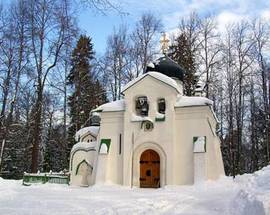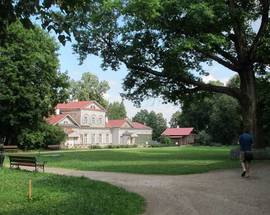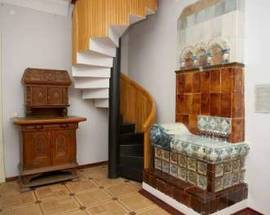Abramtsevo Museum Estate
Mamontov’s influence brought a colony of artists, all of whom were active in the Russian revivalist movement inspired by traditional Russian folk art. Together they built and designed their own houses and collected local folk art and handicrafts all of which you can see here today. Actors and theatre directors were also part of the scene and the colony regularly produced its own premieres of new stage plays and operas. In fact it is even thought that the main manor house was the inspiration for the house in Chekhov’s Cherry Orchard. Of more humble fame is the first Russian doll - which was carved in a workshop on the Abramtsevo estate at the turn of the twentieth Century.
To reach the estate from the Abramtsevo railway station you first need to walk about one kilometre through the forest. Directly behind the station building you will see a path heading into the woods, follow it straight over the stream and keep going straight into the forest. On the way you will pass some dachas, woodland ponds and streams. After crossing a second stream near the main road you will find yourself walking up through a meadow towards the estate. This meadow is actually said to be the place where Viktor Vasnetsov painted his famous depiction of the fairytale Russian heroes the Bogatirs. At the top of the hill to the left is the posh new Galeriya Hotel with its own swimming pool and a good restaurant, to the right is the museum.
The main building of the museum ensemble is the beautiful wooden manor house, which can only be viewed as part of an excursion (taking place approximately every hour). When the Mamontov’s moved in to the manor they decided to preserve some of the interiors that Asakov had left, hence the exhibits are split in to two parts - one part the more art nouveau inspired Mamontov’s taste and the other the more traditional Asakov’s. Next to the manor house is the fairytale studio cottage covered in carved eaves and window frames which functioned as the ceramics studio (under renovation until December 2011) and the Museum of Folk Art based on the colony’s collection of local crafts, which are displayed in what was once the kitchen.
Further on in across the large lawn and through the surrounding trees you will find the bathhouse which was later used as a rest house and writing room. Built in traditional style it is filled with outstanding Russian art nouveau furniture carved with beautiful folk-inspired designs many of which feature the symbol of the colony- an owl. Opposite stands the little "Hut on Chicken Legs" built in honour of Baba Yaga, a witch character from old Russian fairytales.
The artists and their families all worked together to built their own stone church by hand which can be found in a small enclave of trees. With an unusual shape, modern icons on its ceramic and wood iconostasis and much floral decoration, it is considered to be the first art nouveau Russian Orthodox church. The icons were painted by various artists from the collective including Vrubel, Repin, Nesterov and Vasnetsov. Finally towards the back end of the lawn is a small red roofed wooden house which was the home of the Palenovs. Both Mr and Mrs Palenov became famous for illustrating children’s stories and an exhibition of their works can be found inside. If you walk down the hill you will find yourself at a romantic lake which also featured in many landscape paintings created by the artists who were once resident here.
GETTING THERE: Local trains (elektrichki) leave for Abramtsevo about every 40mins - from Yaroslavsky vokzal (metro Komsomolskaya). The journey takes just over one hour. If you are going away for the weekend, a visit to Abramtsevo is perfectly combined with an overnight stay in Sergiev Posad, just 30 minutes further up the railway line. For more on Sergiev Posad check out our Sergiev Posad webpage.
Website
www.abramtsevo.netAmenities
No Credit cards
Facilities for disabled
Guarded parking
Wi-fi
Open
Museums open 10:00 - 18:00, Sat 10:00 - 20:00. Park open 10:00 - 20:00, Sat 10:00 - 21:00. Museums closed Mon, Tue (two museums are on Tue open) and last Thursday of the month.








Comments